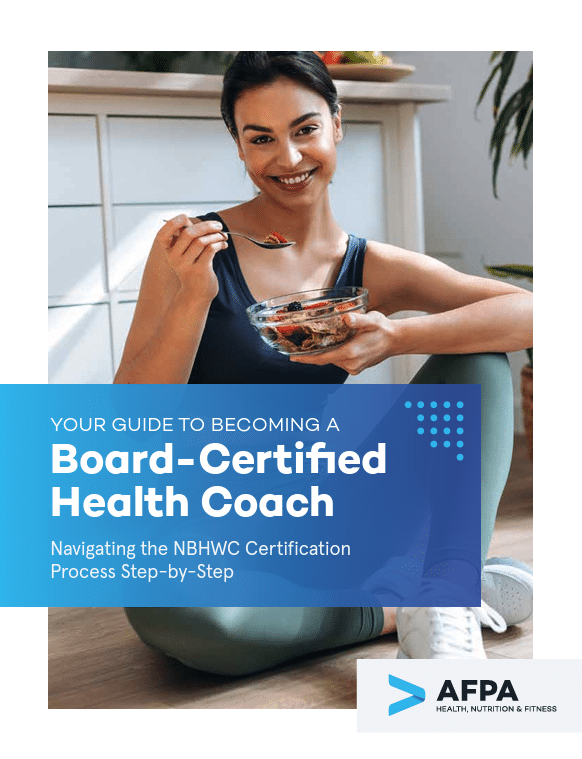Regardless of whether you’re a personal trainer, health coach, or nutritionist, keeping track of clients’ health information can get overwhelming—fast. This is especially true when you have a large base of clients dealing with a unique mix of risk factors and health conditions.
But, missing out on crucial client health information could result in serious health consequences for your client and legal complications for yourself. So, in this article, find key strategies you could use to retain and remember important client health information.

The Essential Business Course for Health and Wellness Entrepreneurs
Gain the skills needed to build and run a thriving, lucrative health and wellness business.
Types of Client Health Information Worth Noting Down
First things first: What constitutes “important health information”? Well, in general, important health information typically falls into three categories:
- Medical history: Includes details about your client’s past and present medical conditions (e.g., heart attack, cardiac surgery, high blood pressure, or diabetes), along with the prescribed medications they’re currently taking.
- Existing symptoms: A list of potentially concerning symptoms include “unexplained chest discomfort without exertion,” “unusual or unexplained shortness of breath,” and “unexplained dizziness, fainting, or blackouts.”
- Lifestyle habits: Does your client smoke? Do they drink excessively (more than one to two drinks daily)? Do they have poor sleeping habits (less than seven hours of sleep nightly)? Cigarette and alcohol misuse, along with inadequate sleep, are amongst the top lifestyle habits that negatively impact fitness and dietary choices.
Note: As a health and wellness professional, all three categories provide important health information you need to obtain from clients as the information will affect the specific types of programs you design.
How to Acquire Important Client Health Information
Admittedly, that’s a lot of information you need to get from your client. Worried about initial client consultation/assessment sessions stretching for hours on end, where you feel like you’re conducting a “rapid-fire question session”?
There’s no need to. That’s what forms (e.g., medical clearance, health history, and symptom questionnaire) are for.
Print them out or send them digitally and have your clients fill them in. Be mindful that your clients’ health conditions and lifestyle habits could be sensitive topics for them. So, you should always inform your clients that their answers to all questions during the health screening session are strictly confidential.
Remind them of the importance of answering all questions as honestly and in as much detail as possible; let them know that the more you know about their health status, the better you can design programs that truly serve their needs.
It’s important to remain non-judgemental and use open and warm body language during all communications with clients.
Retaining and Remembering Important Health Information
Do all the necessary paperwork, and you’ll have a stack of forms relevant to every client on hand. But wait—how do you remember everything without looking like you’re flipping through a textbook during every session?
Keep a File on Every Client
Remember the “stack of forms” previously mentioned? Be careful about mixing up paperwork between clients (e.g., mistakenly thinking Client A has diabetes when they have high blood pressure, and the opposite for Client B).
Keep every client’s file neat and organized. Now, this doesn’t necessarily mean that you need to have physical copies of every client’s file—although you could if you wish.
Instead, you could depend on apps to streamline your client “database.” Beyond offering you convenience, apps also reduce the likelihood of mistaking one client’s health information for another’s.
Here’s a list of the top three coaching apps you could consider using:
- Practice Better: A complete practice management app for health and wellness professionals. In addition to tagging each client with specific notes and documents, you could even set up automated reminders and create downloadable resources for your clients. Other notable features include in-app messaging, session, scheduling, and invoice management (amongst others).
- True Coach: Although designed primarily for personal trainers, health coaches and nutritionists could also use True Coach to track client data (including important health information) and schedule coaching sessions.
- Satori: Once again, Satori allows you to track all clients’ health information. Beyond that, though, this powerful CRM software is particularly beneficial to anyone offering remote coaching services. It auto-detects client time zones and does the math for easy session scheduling.
Summarize Key Health Conditions
Every client has their own file. Great! But that still doesn’t address the potential of information overload, where referring to a client’s “file” (either physically or digitally) brings you down a rabbit hole of symptoms, key considerations, and contraindications.
For instance, imagine that you’re a personal trainer and your client has high blood pressure.
Here’s what your notes could read:
“Client has high blood pressure. It is best to avoid high-intensity exercises like sprinting, powerlifting, plyometrics, and all forms of HIIT training because it could rapidly raise their blood pressure and put too much strain on their heart and blood vessels. The client should, instead, be advised to do moderate activity. The client is on Angiotensin II Receptor Blockers (ARBs), a medication that allows blood vessels to stay open. May cause dizziness.”
Yes—it’s a huge chunk of words. And that only accounts for one aspect of their health information.
In most cases, you’d also need to get through multiple paragraphs covering other health conditions and daily lifestyle habits. It’s a nightmare. So, what can you do about it?
Answer: Take the time to familiarize yourself with the ins and outs of the few common chronic conditions clients typically face (e.g., diabetes, high blood pressure, hypothyroidism, and cardiovascular diseases) and then summarize critical points in your own words. Note: If possible, you should write this summarized information down; preferably in a separate document you could easily refer to whenever the need arises (e.g., a personal journal).
Oh, and if you face difficulties understanding a particular client’s medical condition?
Don’t be afraid to ask your client for a brief explanation. The chances are that their healthcare providers would have given them a concise, easy-to-understand overview of their health conditions—which they could then relay to you.
Benefits of Summarizing and Writing Down Key Health Information
Research shows summarizing to help with comprehending knowledge and transferring it to long-term memory (i.e., the storage of information over extended periods). Writing by hand is also known to increase memory retention and understanding.
Committing key health information to memory allows you to “tag” a specific client with bullet points because you’d be aware of what it entails for your client and how you design your programs. So, here’s how your notes for a client with high blood pressure could look like when you have a deeper understanding of the condition:
“Client has high blood pressure and is currently taking ARBs.” Much more efficient, right?
Keep Your Knowledge Up-To-Date
That said, remember to keep your knowledge up-to-date. Ensuring that your recommendations and advice are aligned with the latest health and nutritional guidelines is key to your client’s wellbeing and the success of your business.
Here are a few tips that’ll help you with this:
- Join a professional association: Becoming a member of a professional association (e.g., The National Board of Health and Wellness Coaching or Health Coach Alliance) typically gives you free access to studies and high-quality information relating to health and wellness fields.
- Sign up for authority newsletters: There are two general types of authority organizations. The first is associations and organizations comprised of experts and professionals in certain fields or on a specific topic. Examples of associations and organizations you may want to follow include the American Nutrition Association and the American Public Health Association. The second type of authority organization is government entities responsible for official guidelines and regulations. Examples include the World Health Organization and ChooseMyPlate.
- Complete continued education courses (CECs): Certifying organizations for health and wellness professionals (including AFPA) offer short courses to allow personal trainers, nutritionists, and health coaches to continue their education and keep their knowledge up-to-date. So, do consider getting your CECs if you haven’t already.
Review Client’s Files Before Their Sessions
Another psychological “trick” you could use to remember important client health information better is something called the “recency effect.”
For those unaware: The recency effect is a memory phenomenon in which the most recently presented facts, impressions, or items are remembered better than the earlier material.
So, how do you make use of this, exactly?
Well, remember the “files” you kept on each client? Be sure to review them right before your coaching session starts. This will keep any relevant health information “handy” in your mind.
Of course, this will mean that you shouldn’t schedule back-to-back client sessions.
Instead, always make sure that you have at least ten to twenty minutes of “breather-space” between clients so you can catch up on any relevant information on the upcoming client to better serve their needs.
Do Periodic Check-Ins
You cannot assume that your client’s health status (i.e., chronic conditions and lifestyle habits) remains the same indefinitely. Instead, it’s something that could change—maybe for the better, maybe for the worse.
And that could affect the effectiveness of the program you design for them.
To illustrate: Imagine that you’re a certified Nutrition & Wellness Consultant with a client who’s been relatively healthy. Thus, your focus with this client has always been on reinforcing positive food habits and behaviors, along with designing meal plans based on MyPlate (a government-recommended revision of the Food Pyramid).
However, unknown to you, your client has recently been diagnosed with celiac disease, an auto-immune disease where the ingestion of gluten leads to damage in the small intestine.
Imaginably, failing to account for this in their meal plans is detrimental to their health. Of course, some clients won’t be shy about sharing their latest health conditions with you. But others may have their reservations about doing so, especially when you haven’t asked.
Another example to highlight is when your client engages in behaviors that directly negatively impact their health and fitness (e.g., smoking again after quitting). Not having access to this new information may cause you to push your client harder than their bodies can handle during training sessions, for instance.
This, in turn, highlights the importance of you performing regular “health check-in sessions” with your clients. Do so at least once every three months.
If your clients aren’t comfortable with the idea of communicating face-to-face, you could also make use of the following “check-in” methods:
- Messaging: If you’re using a coaching app, feel free to set up automated check-in messages along the lines of “Hey, is there anything new I should know about your health to better support you on your journey?” that get sent periodically. But if you’re not, there’s always the option to do so manually (it just takes a little more effort, of course).
- Email: These check-in emails could be a part of your email marketing strategy. As with coaching apps, investing in a good email marketing service provider (e.g., HubSpot, ConvertKit, and Drip) will allow you to send automated check-in emails so you don’t have to manage them manually.
Takeaway
Working with important health information is part of the job as a personal trainer. And it’s essential to handle it well—starting with acquiring and remembering all that information.
It may seem like unexciting and tedious work, but it’s key to helping your clients build a sustainable healthy lifestyle. After all, you want your clients to always feel supported and safe with you.

Learn How to Set Yourself Apart as a Board-Certified Health Coach
References
- https://www.ncbi.nlm.nih.gov/pmc/articles/PMC4703222/
- https://practicebetter.io/features/
- https://truecoach.co/
- https://satoriapp.com/
- https://pubmed.ncbi.nlm.nih.gov/16300454/
- https://www.researchgate.net/publication/285463001_Does_Writing_Summaries_Improve_Memory_for_Text
- https://www.sciencedaily.com/releases/2021/03/210319080820.htm
- https://nbhwc.org/
- https://www.healthcoachalliance.ca/
- https://www.acefitness.org/
- https://theana.org/
- https://www.apha.org/
- https://www.who.int/
- https://www.myplate.gov/
- https://dictionary.apa.org/recency-effect
- https://www.ncbi.nlm.nih.gov/books/NBK441900/
- https://www.hubspot.com/products/marketing/email
- https://convertkit.com/
- https://www.drip.com/



